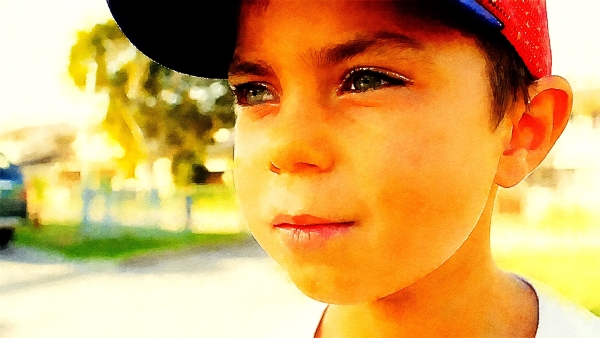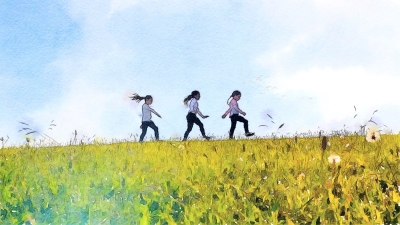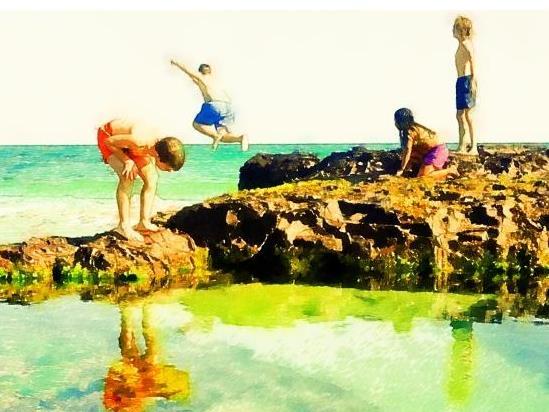Image: ‘Cooper, Logan, Nicky and Jakub from the story in which Logan gets called a chicken.’ Supplied by Beyond Empathy.
Imagine a film shoot that goes on for five years, where the actors, writers and crew are mainly kids under the age of 12. These aren’t rich or privileged children either. They’re from disadvantaged backgrounds, many of them living in public housing. Filming has to take place around school hours, footie commitments, possible trauma and the usual day-to-day chaos of any child’s life.
Just try to imagine the continuity challenges of this setup.
A film made under these conditions sounds like a very worthy community development project, but possibly a bit of chore to watch. The thrilling thing about Protection, a feature-length film made by 100 kids from the Illawarra region of NSW, is that it moves and impresses the viewer, not just with its heartfelt storytelling, but with its audiovisual craft. Instead of the bleak social realism or documentary starkness you might expect, this collage of short narrative pieces all inspired by the children’s real lives, is artful. A storybook effect is frequently achieved without obscuring the identities of the children in any way. This is done by layering rotoscoping, animation, pencil sketch and watercolour effects, to name just a few of the techniques on show. A top-notch sound design and score (done at SoundFirm with crowdfunded money) polishes it off beautifully.
‘A lot of people who watch it say to me, “Oh, it’s actually a real film,” like they’re surprised, because the expectations are pretty low for a community-made film made like this,’ says Gemma Parsons. She’s one of the key adults behind the project, which was made by Beyond Empathy (BE), a not for profit organisation that uses the arts (film, theatre, music, dance, visual arts) to create opportunities for change for people living with disadvantage or hardship.
Funded primarily by the Australian Council for the Arts, and also by Create NSW, Beyond Empathy was created in 2004 by community arts advocate Kim McConville and award-winning filmmaker-youth worker Phillip Crawford (Hurt, 2000; Knot at Home Project, 2006).
Gemma Parsons, a youth worker with a background as a graffiti artist, break dancer and theatre maker came to the organisation in 2006, to work specifically on Illawarra projects. The first film Parsons and Crawford made together this way, collaboratively with a group of teenagers, was the 2013 Rites of Passage, which went on to win a Special Jury Mention at the Warsaw Film Festival as well as a number of other awards.
On this most recent film, Protection, Crawford and Parsons are both technically credited as co-director and co-editor, but the usual hierarchy is done away with, and the names of all those involved are listed alphabetically.

Image: ‘Harry from the story in which the boys band together to prevent their mate from being evicted.’ Source: BE.
No Hierarchy
This radical lack of hierarchy is just one of 10 Dogma-like principles that guided the production, and in the opening sequence of the film, the children talk endearingly to camera about the method. (You can find the complete list of principles at the end of this article. They will make any traditional filmmaker quiver in fear.) They include: ‘Number 3 – There can be no casting process for key actors that involves rejections: ie if they come to the project you must find a way for them be in the film,’ and the rather daunting ‘Number 6 – If an actor fails to turn up, the shoot continues, creating a new direction for the film.’
According to Parsons, Principle Number 8 – ‘The film should be made with different and diverse styles, like a collage’ is an artistic choice that’s made to deal with the limitations of a community-led film. ‘When you are making a film over five years with people who aren’t actors and you have very little control over whether somebody is going to wear the same hat or get a haircut, or something happened and they fell off their bike and suddenly got a big scar on the side of their face, it helps to have a way to disguise some of those things that would cause major continuity issues,’ she says. ‘Having different styles and textures, apart from creating a feel for the film, also has a very practical use for us, to put the audience into a whirlwind so they don’t notice those things so much.’
Phillip Crawford reiterates this, speaking to Screenhub on speakerphone from his car, where he’s driving five of the kids home from a Q&A screening of the film at a school in La Perouse. ‘The animation effect really helped us in the storytelling,’ he says. For example, in the story about the billycart ride, the lead actor, Lily, did two rides one year apart that were meant to happen on the same day and we couldn’t find the original T-shirt she wore. The animation lets you get away with a hell of a lot of things that might otherwise be tricky.’
I take the opportunity of asking the kids in the car what they most liked and disliked about the filmmaking process. They’re all a bit shy and tongue-tied, but several of them do make the point that filmmaking is a laborious process. Shelly, now 14, said, ‘the hardest bit was doing it all over and over again.’ Elwyn, now 12, agreed. ‘Gemma would tell us to do it again, just one more take, but it never was just one more.’ Apparently nobody likes holding the boom mic. They’re not really complaining though, and all seem extremely proud of the finished film.
So how exactly do you go about making a film like this? An existing connection to the community you’re filming with is important in trust building, and loads of time is the key, it seems. ‘We didn’t just hand them cameras and say ‘go nuts’,’ says Parsons. ‘We don’t sit down in a room and start with a script. We take cameras and kids out and ask them what they like to do, where they hang out. They might say they like riding their bikes around the neighbourhood, so we film that, and it helps us get an idea of what sort of character they might be in the film, and also gets them used to being in front of the camera.’
According to Crawford, none of the footage they shot in the first year made it into the final film. That’s a hell of a pre-production period.
‘Often we have story types,’ says Parsons, ‘and that’s important because you want a variety of story types in a collage. We have one story about a girl being bullied, but you don’t want two of them.’
In perhaps the sweetest of the film’s segments, three little girls from a housing estate find themselves in a wealthy suburb next door, playing in a display home, making mischief with all the fake fruit and fittings. The idea for this story came when Parsons asked one of the little girls what kind of story she wanted to be in, and she answered, ‘Cinderella.’
‘We’re not making that kind of story, we want something more real,’ replied Parsons. ‘Goldilocks then?’ asked the girl, still fixated on fairytales.
‘I thought about it a bit, and talked to Phil,’ remembers Parsons, ‘and thought maybe we could make it work if it was three Goldilocks from the housing commission and they found a house in a display village and they just think it’s a fun playhouse, with a real estate agent teddy bear.’

Image: Jallarah, Lully and Nytarlee from the story in which three goldilocks(s) discover a play house. Source: BE.
Stories like this one show how the process can work, and how important it can be to have skilled storytellers guiding the raw ideas.
Now the film is out there in the world for audiences to see, it’s still innovating and evolving both in its form and in its distribution through FanForce screenings. There are multiple versions of the film too, ‘almost like a lego film that you can construct in different versions that might be more suited to different audiences,’ says Parsons. A schools program of cubby house screenings is also underway, where the kids go out and talk to other kids about issues raised in the film.
Ultimately, the success of a film like Protection isn’t in box office success or critical acclaim (though on both measures it’s doing pretty well, with sold out Fanforce screenings, endorsements from the likes of bestselling author Steve Biddulph, film critics Megan Spencer and Andrew Bunney, and Artshub’s own business development manager, Danni Petkovic, who saw the film and raved so much we felt compelled to follow it up.) Instead, the success of the film can be found in the effect it has on the kids involved.
‘We’re not setting out to make little filmmakers or little actors,’ says Parsons. ‘What we want to do with these projects is to instill a sense of self-esteem and confidence because a lot of these kids don’t have the opportunity to shine elsewhere. They’re not picked for school captain and things like that, so having an opportunity to feel proud and achieve something, to think of themselves in a different way and have other people think of them in a different way, that’s the important thing.’
Protection Trailer #2 from BE Films on Vimeo.
The Ten Principles for making Protection – Lars von Trier eat your heart out.
1. The making of the film should help people living with hardship to build new futures
2. All key actors must be amateurs and live in the community where the film is shot
3. There can be no casting process for key actors that involves rejections: ie if they come to the project you must find a way for them be in the film.
4. There can be no traditional script and there must be more than one story line
5. The story lines must be developed with the actors, drawing on their life experiences
6. If an actor fails to turn up, the shoot continues, creating a new direction for the film
7. Where possible, everyone (actors and production team) should have a go at the technical aspects of making the film: using cameras, sound recording, lighting, and other processes.
8. The film should be made with different and diverse styles, like a collage.
9. No one can be credited as the author or creator, the credits should be alphabetical not hierarchical.
10. The film should bring people in the community together and the first screening must be held in the community where the film was made.
To organise a FanForce screening of Protection Click Here.





